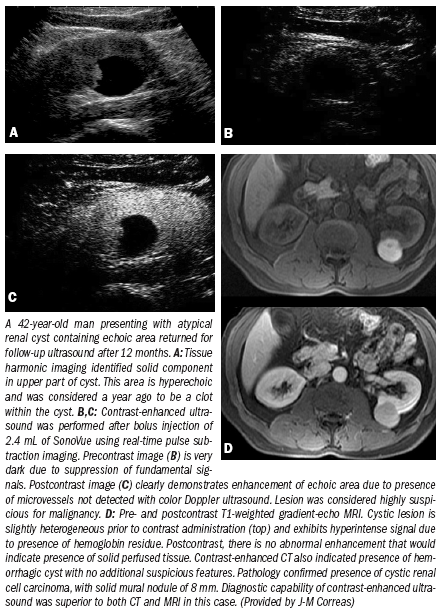Microbubble options extend well beyond liver
Applications for ultrasound contrast continue to grow, fueled by the safety and stability of microbubble agents and the widespread availability of ultrasound units, according to speakers at ECR 2009.
Applications for ultrasound contrast continue to grow, fueled by the safety and stability of microbubble agents and the widespread availability of ultrasound units, according to speakers at ECR 2009.
Microbubbles used as contrast are typically made up of a water-insoluble fluorinated gas trapped within a thin, biocompatible shell. When the contrast is exposed to an ultrasound field, pressure changes cause the microbubbles to resonate. These vibrations, and the subsequent bubble destruction, generate strong backscattered signals that enhance resulting ultrasound images.
The biocompatible microbubble shell can be coated with ligands, such as antibodies, that seek out targets in the endothelium, Alexander Klibanov, Ph.D., told delegates at an ECR refresher course. This type of targeted imaging was initially thought to be unworkable. Bench-top experiments and animal imaging are now proving the skeptics wrong.
“This is truly molecular imaging. We can have as few as 10 to 100 molecules per square micron, the microbubble will attach, and we will be able to see it,” said Klibanov, an associate professor of biomedical engineering at the University of Virginia in the U.S.

He outlined how the three key requirements for targeted ultrasound imaging are being met by researchers. The technique must be sensitive, that is, imaging should show the microbubbles attaching to their targets. It must be stable; the microbubbles should stay in the bloodstream long enough to reach their target, but not too long. The third important factor is selectivity. Functionalized ultrasound contrast should accumulate at the target site and nowhere else.
The next challenge is to translate the early proof-of-concept studies into clinically useful, safe, efficient, and practical applications. Targeted contrast-enhanced ultrasound could potentially be used in a wide range of applications, including diagnostics, image-guided biopsies, and treatment follow-up.
“Ultrasound is an imaging modality for everybody. There are already many contrast agents available and more at the development stage. Millions of examinations are performed every year now with contrast,” Klibanov said.
The detection and characterization of focal liver lesions remains the main indication for contrast-enhanced ultrasound in clinical radiology, said Prof. Jean-Michel Correas, a professor of radiology at the Necker Hospital in Paris.
The late phase of enhancement is particularly important when characterizing lesions in the noncirrhotic liver. Lesions exhibiting sustained late-phase enhancement will be benign in more than 95% of cases. The pattern of enhancement in the arterial phase must then be considered in order to distinguish among focal nodular hyperplasia, hemangioma, or perhaps focal fatty changes. Hypoechoic or hypointense enhancement in the late phase is suggestive of malignancy.
For patients with cirrhosis, it is more important to concentrate on the arterial phase, Correas said. Strong arterial enhancement in this patient group is suggestive of hepatocellular carcinoma, though HCC cannot be ruled out even without arterial enhancement. An atypical HCC may still be detected from iso- or slightly hypoechoic late-phase enhancement.
Contrast can also be administered prior to ultrasound-guided radiofrequency ablation of liver metastases to highlight areas of lesion vascularity. Post-treatment contrast-enhanced scans should also reveal any areas that have been missed or sites where tumor is regrowing.
Renal imaging is another area in which contrast-enhanced ultrasound techniques are showing considerable clinical potential. One benefit of using microbubble agents, instead of iodinated CT contrast or gadolinium-based MRI agents, is that patients can be reinjected and imaged again if necessary.
“Ultrasound contrast agents have a good safety profile. There is no problem in the case of renal failure and no renal toxicity,” Correas said.
The value of the microbubble agents for the detection and characterization of solid masses appears limited in the kidney. Contrast-enhanced ultrasound can, however, add value when characterizing complex cystic masses (see figure), monitoring ablation of solid tumors, and investigating abnormal vascular disorders.
Delegates were shown images of a patient with a suspected renal abscess. The diagnosis on color Doppler ultrasound had been unclear. Injection of contrast solved the mystery, revealing multiple enhancing aneurysms.
“The moment we gave the contrast agent, we knew the diagnosis,” Correas said.
Ultrasound perfusion imaging could play a particularly important role in detecting segmental and subcapsular infarction in clinical transplant patients in the future. He recommends using smaller doses of contrast when reinjecting these patients and following the bolus on color Doppler imaging. This technique should help avoid blooming artifacts, which can obscure the vessels being studied.
GE HealthCare Debuts AI-Powered Cardiac CT Device at ACC Conference
April 1st 2025Featuring enhanced low-dose image quality with motion-free images, the Revolution Vibe CT system reportedly facilitates improved diagnostic clarity for patients with conditions ranging from in-stent restenosis to atrial fibrillation.
The Reading Room Podcast: Current Perspectives on the Updated Appropriate Use Criteria for Brain PET
March 18th 2025In a new podcast, Satoshi Minoshima, M.D., Ph.D., and James Williams, Ph.D., share their insights on the recently updated appropriate use criteria for amyloid PET and tau PET in patients with mild cognitive impairment.